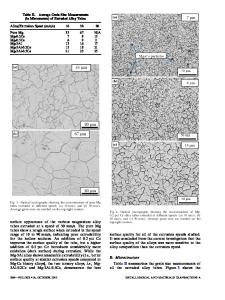Microstructure and Mechanical Properties of an Extruded Fe30Ni20Mn25Al25 Alloy
- PDF / 1,514,484 Bytes
- 6 Pages / 612 x 792 pts (letter) Page_size
- 63 Downloads / 335 Views
0980-II01-02
Microstructure and Mechanical Properties of an Extruded Fe30Ni20Mn25Al25 Alloy J. A. Loudis, T. C. Boyd, D. A. Coen, and I. Baker Thayer School of Engineering at Dartmouth College, Hanover, NH, 03755-8000, USA
ABSTRACT A spinodal alloy, Fe30Ni20Mn25Al25, was produced by casting followed by hot extrusion. The microstructure consisted of coherent, 20-30 nm wide rods of alternating body-centered cubic (b.c.c.) and ordered B2 phases aligned along . The room temperature mechanical properties were determined under compression over a range of strain rates. The as-extruded yield strength, which was strain-rate dependent, was ~1400 MPa. Annealing at 550°C led to the precipitation of large unit cell cubic phase and to an increase in hardness. Post-mortem TEM analysis of the compressed specimens identified dislocations having Burgers vectors. INTRODUCTION Recently, we observed that spinodal microstructures occur in the Fe-Ni-Mn-Al system over a wide compositional range near the equiatomic composition [2,3,7-9]. The very fine spinodal microstructures (5-60 nm) typically consist of alternating b.c.c. and B2 phases, but further ordering of the latter phase to the L21 structure has also been found [3]. Such spinodal alloys typically exhibit high yield strengths due to the compositional fluctuations created during the decomposition [1]. The most studied alloy, arc-cast Fe30Ni20Mn25Al25, showed as-cast hardness and yield strength values of 504 +/- 8 HV and 1510 +/- 50 MPa, respectively [2]. These increased to 772 ± 28 HV and 2350 MPa after annealing at 550°C for 115 hours. Transmission electron microscopy (TEM) observations showed that the alloy consisted of coherent alternating b.c.c. and B2 rods aligned along with widths of 50-60 nm. Energy dispersive spectrometry (EDS) indicated that the b.c.c. phase had a composition (in at. %) of Fe-49.6; Ni1.6; Mn-30.0; Al-19.3 while the B2 phase had a composition of Fe-12.7; Ni-34.3; Mn-13.9; Al38. Electron probe microanalysis showed the overall elemental composition of the alloy was within 0.4 at. % of the nominal values [2]. After annealing at 550°C elongated incoherent precipitates of composition Fe-45.5; Ni < 1; Mn-42.0; Al-12.3 were observed. This paper presents a further analysis of this alloy, in this case produced by casting followed by hot extrusion. The results are compared with previous observations on ingots of this composition produced by both arc melting and simply melting and freezing methods. EXPERIMENTAL A cylindrical ingot with a nominal composition Fe30Ni20Mn25Al25 was drop cast at the NASA-Glenn Research Center, Cleveland, OH and hot extruded in a steel can at 1044°C with an area reduction ratio of approximately 5.5:1 at General Electric Global Research Center, Niskayuna, NY. EDS analysis confirmed that the composition of the extrusion was within 2 at. % of previously studied ingots [2].
Optical microscopy was used to characterize the as-extruded grain structure. Samples were taken in both transverse and longitudinal directions, polished to a mirror finish
Data Loading...











